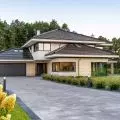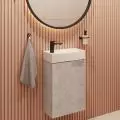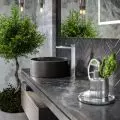The article is from the 09/2022 issue of A&B
School in Poland often appears as an ossified institution that remains indifferent to changes in the surrounding world. We perceive it through the prism of gloomy thousand-room classrooms, uncomfortable desks and overly heavy school bags. We don't notice that next to us "grassroots work" is brewing, and architects, introducing modern solutions into the schools they design, are setting them on the road to the future.
Lesson 1: How to design a school?
Designing a school is a serious matter. Perhaps even too serious to be left to architects alone. Over the years, central and local governments have created guidelines for new investments in the educational field. The introduction of compulsory universal education in the Second Republic and the deficiencies in school infrastructure, which still dated back to the partition period, entailed the construction of hundreds of facilities. The Ministry of Religious Denominations and Public Enlightenment therefore provided ready-made designs, and designers themselves often used ministerial materials as sources of inspiration. In People's Poland, the widespread campaign to build "a thousand schools for the Thousandth Anniversary of the State" resulted in both individually designed buildings and a number of typical designs created on the basis of top-down guidelines. This, in many respects, exemplary tradition of "helping architects" is now being continued by the Warsaw authorities, which in 2020 issued a study entitled "School Well Designed." It was created in cooperation with the WWAA studio and is a collection of good practices in shaping the space of educational facilities.
School and kindergarten complex in Przybysławice, proj.: ARP Manecki (Mateusz Manecki, Magdalena Ślebioda, Dawid Leszczyński, Bartosz Falkowski, Maciej Oczkowski, Klaudia Woźniak, Weronika Krauze)
photo: Piotr Król
Designers cannot wait with folded hands for systemic changes. On the contrary, in view of the imperfection of the system, it is on them that a huge responsibility lies to work at the grassroots. Since students and their parents complain about a curriculum that is unsuited to the demands of modern times, a precocious canon of reading or excessive hourly workloads, it is architecture that can compensate for the resulting inconveniences.
"According to research in the field of environmental psychology, architecture as much as possible can support the educational process and support children in learning through a properly designed environment, the so-called architectural determinism in question, in the case of children's facilities, is a very important tool through which we, as architects, can create spaces conducive to the development of specific aspects of a child's functioning (memory, concentration, but also motor skills, agility, etc.)." - ARP Manecki studio designers emphasize.
Elementary school in Milicz, proj.: PORT Józef Franczok, Marcin Kolanus
photo: Stanislaw Zajączkowski
lesson 2: Aesthetics
In "Bathtub with a Colonnade," Filip Springer cited data on the number of hours of art education in the elementary school curriculum of European Union countries. Poland fared badly in this comparison, with our students devoting several times less time to art education than their peers in Denmark or Portugal.
elementary school in Milicz, design: PORT Józef Franczok, Marcin Kolanus
photo: Stanislaw Zajączkowski
"Ugliness forms ugly people, who have no need for beauty," thundered architect Boleslaw Kardaszewski in the 1980s. Italian designers in the interwar period already knew about the role that the environment in which people spend their early years plays in shaping their aesthetic attitudes. When designing schools or recreation centers for children, they remembered that every detail - from the proportions of the windows, to the colors of the walls, to the way the railings of the railings are profiled - is remembered by the young users and becomes a point of reference in adulthood. "Good architecture helps us see the role of space in our daily comfort of functioning, and growing up in a good space shapes sensitivity to its quality," emphasizes Jozef Franczok of the PORT studio. A well-designed school building can therefore be worth more than an extra hour of art in the school schedule.
Elementary school in Książenice, design: PALK Architects (Piotr Hardecki, Marta Czarnomska-Siecke, Krzysztof Łaniewski-Wołłk, Łukasz Stępniak)
Photo: Bartosz Makowski www.makowski.co
Through simple, resource-saving building forms, the designers send a clear message - let's start taking children seriously. School buildings familiarize the youngest with modern aesthetics, and unplastered brick or raw concrete provide the perfect backdrop for their activities. "Raw" materials, used in the interiors of the school in Książenice by PALK Architects (lead designer Piotr Hardecki), perfectly harmonize with the vivid colors of the floor lined with natural linoleum, which, depending on the children's invention, can be a field for games and play. In the neo-modernist school building in Chwarzno-Wiczlin, a district of Gdynia (design: Piotr Hardecki Architekt and LWS architects), graphic ordering of the monochromatic interior space was introduced using elements related to its functionality (such as guide lines for the visually impaired) and furniture with distinctive colors. Indeed, instead of safe pastelosis, designers are increasingly willing to reach for bold compositions. The corridors of the building in Przybysławice (design: ARP Manecki) are enlivened by bright accents of orange. In the interiors of the school in Weso³a (design: xystudio), white and gray colors are adjacent to large planes of black and juicy yellow. The overall design harmonizes perfectly with the simplicity of the building's modern forms and interior furnishings. A step further was taken by designers from the PORT studio, who treated the Milicz elementary school building as a textbook of modern design. The former bauble factory, where the school is located, is dominated not only by industrial aesthetics diversified with furniture by leading Polish designers. Alongside steel pipes and nets and Oskar Zięta's furniture, one can find information about different typefaces or Corbusier's Modulor "explaining" the secrets of proportions. Although Milicz will not become a second Dessau, but the youngest through daily contact with modern design and design become familiar with good practices.
Elementary school in Książenice, design: PALK Architects (Piotr Hardecki, Marta Czarnomska-Siecke, Krzysztof Łaniewski-Wołłk, Łukasz Stępniak).
Photo: Bartosz Makowski www.makowski.co
lesson 3: Functionality
"At a time when the world around us is so full of stimuli, it becomes most important to design a space that is simple, functional and not overpowering on the one hand, and on the other hand interesting enough so that being in it is not just an unpleasant chore, but also an interesting experience. Both the solid and the interior should educate in young people a sense of aesthetics and coherence with the environment, also intrigue and draw them in." - this is how architects from the ARP Manecki studio described the challenges faced by a school designer.
The time of repetitive typical designs is gone. Today's schools are individually designed buildings whose forms result not only from the specifics of their function, but also from the conditions of their surroundings. The school cannot be an "alien" element. On the contrary - it should fit into the existing situation, be treated as "its own" by both students and the entire local community. Hence the formal differentiation of buildings depending on the spatial context. For on the one hand we have the sloping roofs and wooden cladding of the facade of the school in Baranow (design : New Architects) and the fragmented mass of the brick tiled unit in Książenice (design : PALK Architects).: PALK Architekci), on the other - cubic pavilions in Gdynia (proj.: Piotr Hardecki Architekt and LWS architekci) or in Warsaw's Kabaty district (proj.: Maciej Siuda) or the metropolitan architecture of a high school in Gliwice (proj.: ARP Manecki). The authors of the latter project were also responsible for the realization of the school and kindergarten complex in Przybysławice, where the relationship with the environment is built both through the scale of the building, its proportions and the shape of its body, as well as the reference to the hills of the Krakow-Częstochowa Jurassic Upland through the skillful shaping of the terrain and the use of local stone.
As early as 1954, Stanislaw Lukasiewicz wrote in "Architecture of Schools" about the importance of making students feel "at home" in school. The same goal guides contemporary designers. "A school building should be a place that is important for the local community," - says Piotr Hardecki and draws attention to the role of the entrance area of the building, which should be preceded by a carefully designed plaza or square. It provides not only a foreground for a locally important building, but also a safe, intimate semi-public space. The school building itself, on the other hand, should stimulate a variety of activities, rather than being merely a "learning machine." One of the key aspects is the multifunctionality of the designed space. Anyone who remembers janitors admonishing students not to run in the hallway or sit on windowsills can look with envy at interiors that directly encourage this type of interaction. The aforementioned floor in Książenice, which can become a game board, is just one example. At the same school, the cafeteria space is also a relaxation zone for students. In turn, at the elementary school in Baranow, the New Architects studio designed "boxes" - spacious alcoves lined with wood and colorful cushions. Students can use them in any way they like, as well as the spacious lobby, where wooden stairs serve as seats during breaks and turn into stands during school events.
lesson 4: nature
The multifunctionality of the design solutions adopted allows students to develop their natural creativity. At the same time, they prove that it is possible to talk about important issues in language that is accessible and understandable. Sustainable and environmentally friendly materials do not have to be ugly and boring, limited to technology. Piotr Hardecki, who took care of the blue-green infrastructure of the Książenice school with the other authors back in 2010, pays close attention to its functionality and aesthetics. Each patch of biologically active area on the plot serves as a retention basin, which does not prevent the simultaneous use of lawns as a place for play and recreation, since playgrounds designed on elevated land, after heavy rains take the form of islands.
elementary school in Weso³a, design: xystudio (Filip Domaszczyñski, Marta Nowosielska, Dorota Sibiñska)
Photo: Filip Domaszczyński © xystudio
Responsible design is about providing optimal conditions for the use of a building, while limiting the negative impact on the environment. Sensible management of rainwater, planning flat roofs as biologically active space or conscious use of solar energy through the use of shade-casting fins and windows of varying sizes depending on the side of the world are an important part of the designs of schools in Książenice and Gdynia. Building environmental awareness is one of the tasks that Hardecki believes a modern school should fulfill. "The program should be expanded to include such topics as learning to cook and eat healthy food, the basics of growing fruits and vegetables, and composting skills - this can be accompanied by equipped classrooms, greenhouses and composters placed on the school plot," - he says.
A school in Wesola is also a remarkable example of environmental responsibility. Architects from the xystudio studio refused to develop the project in the designated location because it involved cutting down twenty trees. Instead, they proposed a new site through which a high earthen embankment ran. The result was a building integrated into the terrain ("buried" - as the designers themselves call it), where in some of the classrooms the countertops are at ground level, and children can admire "what's in the grass" through the windows. Nesting boxes have appeared on the salvaged old-growth trees, and their occupants have become full-fledged users of the school.
break: Ah, the youth of today....
Thinking about a modern school is often limited to a multimedia whiteboard, soft poufs and tablets. Meanwhile, they are only add-ons - necessary, but not crucial in the process of adapting the school to the challenges of today. Far more important is to create an environment in which everyone, students and teachers, feels comfortable and safe.
In a world where students are constantly bombarded with sound and visual stimuli, a school must provide opportunities for tranquility. High-acoustic suspended ceilings and natural (and therefore non-allergenic) carpeting reduce noise. "Boxes" and niches provide at least a substitute for intimacy. Diverse architecture open to greenery sensitizes us to the problems of the surrounding world. Designed in accordance with new trends, the interiors shape individuals who in the future will be sensitized to the aesthetics of their surroundings.
Elementary school in Wesola, design: xystudio (Filip Domaszczyński, Marta Nowosielska, Dorota Sibińska).
photo: Filip Domaszczyński © xystudio
When discussing modern school architecture, however, the issue of the human factor cannot be overlooked. "The building can be a very helpful supporting tool, but given a choice between investing in staff or in architecture, I would choose the first option without hesitation." - emphasizes architect Piotr Hardecki.
School in Baranów, design: New Architects (Jacek Nesterowicz, Adriana Was)
photo: Maciej Lulko







































